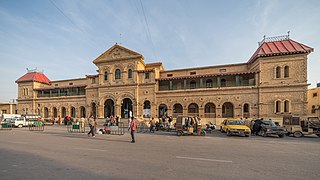
Karachi is the most populous city in Pakistan and one of the most populous cities in the world, with a population of over 20 million. It is situated at the southern tip of the country along the Arabian Sea coast. It is the former capital of Pakistan and capital of the province of Sindh. Ranked as a beta-global city, it is Pakistan's premier industrial and financial centre, with an estimated GDP of over $200 billion (PPP) as of 2021. Karachi paid $9billion as tax during fiscal year July 2021 to May 2022 according to FBR report. Karachi is Pakistan's most cosmopolitan city, linguistically, ethnically, and religiously diverse, as well as one of Pakistan's most secular and socially liberal cities. Karachi serves as a transport hub, and contains Pakistan’s two largest seaports, the Port of Karachi and Port Qasim, as well as Pakistan's busiest airport, Jinnah International Airport. Karachi is also a media center, home to news channels, film and fashion industry of Pakistan. Most of multinational companies and banks have their headquarters in Karachi. Karachi is also a tourism hub due to its scenic beaches, historic buildings and shopping malls.

The Aga Khan University Hospital (AKUH) in Karachi, established in 1985, is the primary teaching site of the Aga Khan University's (AKU) Faculty of Health Sciences. Founded by the Aga Khan, the hospital provides a broad range of secondary and tertiary care, including diagnosis of disease and team management of patient care.

Mayor of Karachi is the executive of the Karachi metropolitan corporation and the Karachi local government system of the city of Karachi which is the third tier of governance in Pakistan after Federal and provincial governments.
Karachi Development Authority (KDA) was established as the city-planning authority of Karachi in 1957, and replaced the earlier Karachi Improvement Trust (KIT). KDA, along with the Lyari Development Authority and Malir Development Authority, is responsible for the development of undeveloped lands around Karachi. KDA came under the control of Karachi's local government and mayor in 2001, but was later placed under direct control of the Government of Sindh in 2011. City-planning in Karachi, therefore, is devised at the provincial rather than local level.

Karachi Metropolitan Corporation is a public corporation and governing body to provide municipal services in Karachi, the largest city of Pakistan.
Moinabad is one of the residential neighbourhoods of Karachi, Sindh, Pakistan. It is part of Landhi Town in Karachi city.
Malir Development Authority was established to oversee the development of Malir in Karachi, Sindh, Pakistan. It was merged with the City District Government Karachi in 2001 but were reinstated after its dissolution.
Lyari Development Authority (LDA) was established in 1993 by the Government of Sindh to oversee the development of Lyari, Karachi, Sindh, Pakistan. It was merged with the City District Government Karachi in 2001 but were reinstated after its dissolution.
Karachi, Pakistan was a federation of eighteen autonomous boroughs, called "Towns," that made up the City District of Karachi from 2001 until 2011. Under this now-defunct system, Karachi had a local government system, with a mayor empowered to make decisions in regards to city-planning and administration of local services. The system was abolished in 2011, and Karachi was divided into 5 City District Municipal Corporations, with a 6th formed in 2013. Each Municipal Corporation now has its own Chairman and Deputy Chairman. The Karachi Development Authority, which controls city-planning and administration of services in Karachi, is no longer controlled at the local level, but is instead administered by the province directly.
The City District Government Karachi (CDGK) was a local government of Karachi, Pakistan. It was established through a local government ordinance (LGO) in 2000, which also established various other district governments in Pakistan. It was headed by the mayor and was formed under the presidential rule of Pervez Musharraf in 2001. CDGK existed until 2010.
The Clifton Fish Aquarium was an aquarium located in Clifton, Karachi, Pakistan, near to Abdullah Shah Ghazi's shrine. It was in operation from 1965 to 1998. It was Karachi's largest public aquarium.

Karachi Cantonment Railway Station is one of the busiest and principal railway stations in Karachi, Sindh, Pakistan. It is situated near Dr. Daudpota Road, Saddar.

The Politics of Karachi takes place at the municipal, provincial and federal levels of the government. Karachi is a multiethnic, multilingual, multicultural and multireligious metropolitan city. The demographics of Karachi are important as most politics in Karachi is driven by ethnic politics.

Jinnah Sindh Medical University, formerly known as Sindh Medical College, is a medical university in Karachi, Sindh, Pakistan. It gained university status in June 2012.
The Government of Karachi is the administrative body for the city of Karachi, Pakistan. Presently the Karachi Local Government system consists mainly of the Karachi Metropolitan Corporation, headed by the Mayor or Administrator.
The following is a timeline of the history of the city of Karachi, Pakistan.

The Karachi Conservancy Board was established in 1846 to control cholera epidemics in Karachi during British rule.
Karachi Municipal Committee was a public corporation established in 1853 in Karachi, Sindh, Pakistan.
Karachi Water and Sewerage Board (KWSB) is responsible for production, transmission and distribution of potable water to the citizens of Karachi, Sindh, Pakistan.







